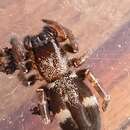en
names in breadcrumbs


Male distinguished by the presence of a keel on the outer margin of the embolus near the distal maximum of the embolic arc (Figs 7C, 10A), absent from other species (Fig. 14A).
Female distinguished from other planus group species as follows: from P. zulu by the lack of an invagination on the posterior margin of the PL (Fig. 16D); from the remaining planus group species by the posterior margin of the AL, which is only slightly recurved and farther from the epigastric furrow than in other species (Fig. 12A). Further distinguished by the presence of only two rows of ventral macrosetae on the first tibiae and metatarsi, with three rows in other species.
Known from Eastern Cape Province, South Africa.
Carapace brown, rugose, covered by fine black setae, with broad white setae concentrated in thoracic region (Fig. 9A). Sternum dusky pale yellow (Fig. 9B). Chelicerae brown, with six promarginal teeth, three retromarginal teeth (Fig. 2D); with fine black setae only. Legs brown basally, pale yellow distally. Abdomen dark gray dorsally with pair of narrow light dorsolateral patches, covered with mixture of fine black and broad white setae (Fig. 9A).
Male pedipalp: Outer retrolateral tibial apophysis (RTA1) with tips long, diverging, inside tip curved ventrally (Figs 7F, 10A). Dorsal ridge long, extending from base of RTA1 nearly to bifid part (Fig. 7F). RTA2 with apex long, slender, curved dorsally (Figs 7B, 10C). MA without anterior lobe arising from tail. Embolus with keel along outer margin terminating near distal maximum of embolic arc forming notch; bifid distal region formed from transparent dorsal process and pointed distal tip (Figs 7F, 10A).
Epigynum: AL subtriangular, clearly differentiated from surrounding cuticle, posterior margin concave; PL nearly half length of epigynum, with parallel grooves (Fig. 12A).
Male macrosetae: Leg I: femur d1, tibia r2-1-2, v1-2-2, metatarsus r1-1, v2-2-2; leg II: femur d1, tibia r2-2, v2-2-2, metatarsus r1-1, v2-2; leg III: femur d1, tibia p1-1, r1, v2-2-2, metatarsus p1, r1-2, v1-2; leg IV: femur d1, tibia p1-1-1-1-2-1, v2-2-2-2, metatarsus p1-1, r1, v1-2, tarsus r1.
Female macrosetae: Leg I: tibia v1-2, metatarsus v2-2; leg II: metatarsus v2-2; leg III: metatarsus v2; leg IV: metatarsus v1-1-2, tarsus r1. All femora with one dorsal seta slightly thicker and longer than the others.
Genbank accession numbers FJ948973 (28S rDNA), FJ948889 and FJ948931 (18S rDNA), FJ949050 (Histone H3), FJ949013 (cytochrome oxidase I).
Paratype male (CASENT 9024962): Total length 5.3, carapace 2.22 long, 1.61 wide, 0.45 high, sternum 1.23 long, 0.75 wide. Leg measurements:
Leg I
Femur: 1.13
Patella: 0.60
Tibia: 0.87
Metatarsus: 0.99
Tarsus: 0.53
Total: 4.13
Leg II
Femur: 1.08
Patella: 0.57
Tibia: 0.71
Metatarsus: 0.87
Tarsus: 0.40
Total: 3.63
Leg III
Femur: 0.87
Patella: 0.46
Tibia: 0.56
Metatarsus: 0.67
Tarsus: 0.33
Total: 2.89
Leg IV
Femur: 1.27
Patella: 0.63
Tibia: 1.04
Metatarsus: 0.83
Tarsus: 0.40
Total: 4.17
Holotype female (CASENT 9024985): Total length 4.6, carapace 1.75 long, 1.30 wide, 0.38 high, sternum 1.06 long, 0.59 wide. Leg measurements:
Leg I
Femur: 0.80
Patella: 0.46
Tibia: 0.51
Metatarsus: 0.54
Tarsus: 0.29
Total: 2.60
Leg II
Femur: 0.76
Patella: 0.43
Tibia: 0.46
Metatarsus: 0.49
Tarsus: 0.29
Total: 2.43
Leg III
Femur: 0.63
Patella: 0.37
Tibia: 0.38
Metatarsus: 0.36
Tarsus: 0.22
Total: 1.97
Leg IV
Femur: 0.99
Patella: 0.54
Tibia: 0.81
Metatarsus: 0.56
Tarsus: 0.25
Total: 3.14
Pedipalp
Femur: 0.45
Patella: 0.21
Tibia: 0.19
Metatarsus: —
Tarsus: 0.38
Total: 1.23
Prey remains (CASENT 9024960) suggest a diet dominated by Formicidae (especially Camponotus and Lepisiota) with some Coleoptera and Hemiptera.